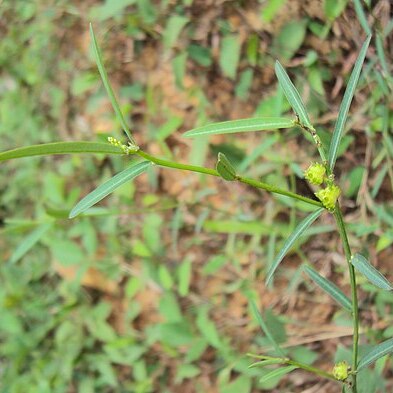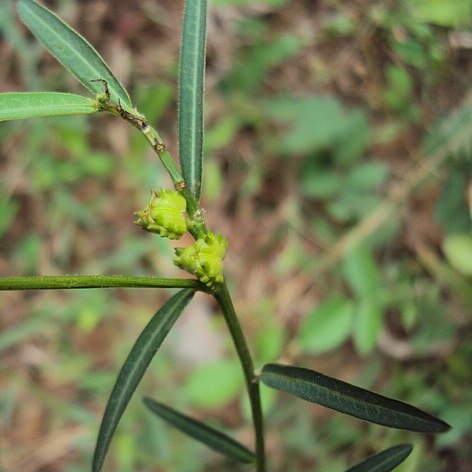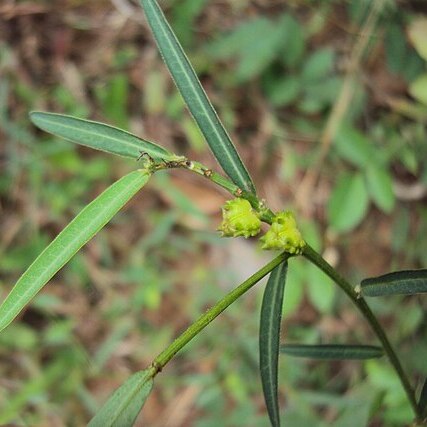Perennial herbs to many-stemmed subshrubs, 20-60 cm tall; main root long, to 5 mm thick; lateral roots slender; stem ± woody at base, branching dichotomous, slightly angular, glabrous or pubescent when young. Stipules persistent, ovate, ca. 1 mm, ciliate, apex acuminate; petiole ca. 2 mm, usually pubescent; leaf blade linear or linear-lanceolate, 20-55 × 2-10 mm, thickly papery, abaxially pubescent, base slightly attenuate, usually with paired concave glands, margins densely serrulate, apex obtuse; midrib prominent on both surfaces, lateral veins 15-30 pairs, obscure. Inflorescence 5-12 mm, lower part with 1 or 2 female flowers, upper part with many spirally arranged male flowers. Male flowers: bracts ovate, ca. 0.5 mm, apex acuminate, mostly covered by a pair of large spatulate glands; each bract 1-or 2-flowered; sepals ovate, ca. 0.5 mm, margins ciliate-serrulate; stamens with filaments much shorter than anthers. Female flowers: bracts lanceolate, ca. 1 mm; sepals slightly larger than in male, broadly ovate, margins fimbriate, sometimes with 2 glands at base inside; ovary triangular-globose, glabrous, with 6 rows of spines; stigmas free. Capsules triangular-globose, 3.5-4.5 mm, lobes softly spiny, spines reddish. Seeds subterete, smooth, 2.5-2.75 mm. Fl. and fr. Mar-Nov. n = 14.
More
Erect to sprawling perennial herb or subshrub to 1 m high. Stipules triangular to lanceolate, 1–2.5 mm long, 0.5–0.8 mm wide. Leaves: petiole 0.5–3 mm long; lamina elliptic, linear-lanceolate, narrow-oblong, narrow-elliptic or obovate, 20–90 mm long, 2–19 mm wide; base cuneate to nearly attenuate; margins minutely serrate; tip acute, obtuse or rounded. Male flowers in clusters of 1–3, pedicels up to 0.2 mm long; sepals ovate, 0.3–0.5 mm long, 0.3–0.5 mm wide; stamens 3, filaments 0.2–0.4 mm long, anthers globose, 0.1–0.2 mm long, 0.2–0.3 mm wide. Female flowers solitary or rarely paired, sessile or shortly pedicellate to 0.8 mm long; sepals narrow-ovate to orbicular, 1–2 mm long, 0.5–1.5 mm wide; ovary ovoid, 0.8–1 mm long, 0.8–1 mm diam.; styles 0.7–1.2 mm long. Fruit ovoid, 5–7 mm long, 4–6 mm wide. Seeds obloid, 3.5–4 mm long, 2–2.5 mm wide, brown to grey.
Beaches, sandy sites, roadsides and waste places, also on lateritic outcrops, dry dipterocarp forest, grassfields, and open woodland, often gregarious; at elevations up to 300 metres. A weed in Pennisetum and Sorghum cultivations on sandy soils.
More
Grows in eucalypt forest and woodland on a variety of substrates.



